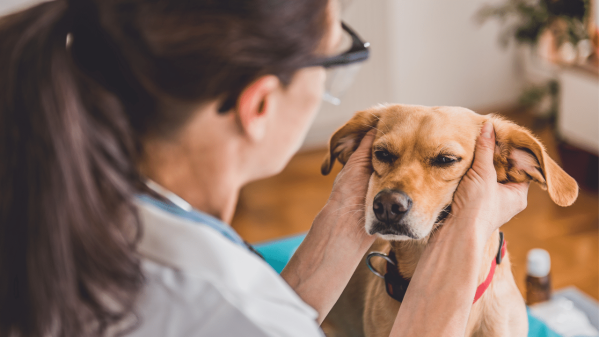Ear infections (officially known as otitis externa) are very common in dogs. Pups with long, floppy ears like Cocker Spaniels and Old English Sheepdogs are especially predisposed to ear infections.
To better understand how ear infections are diagnosed and treated, it's important to know the anatomy of the ear canal in a dog. The part of the ear canal you can see is the first part of the vertical canal (the part that runs straight down). After this, the ear canal makes an angle of nearly 90 degrees and then runs horizontally to the eardrum (tympanic membrane). The horizontal and some of the vertical canal can only be seen and examined using an instrument called an otoscope, so this is why it's vital to have a vet check your dog’s ear if you suspect a problem.
Read on to learn about the signs, causes, and treatments of ear infections in dogs.
Signs your dog has an ear infection
Symptoms of ear infections in dogs can be mild and progressive or can seem relatively severe from the first time you notice it.
Signs of ear infections in dogs include:
Head shaking
Scratching the irritated ear
Yellow or black discharge from the ear canal
Foul odor coming from the ear
Redness around the ear canal
Scaly skin, crusting, or scabs in the ears
Bleeding from the ears
Loss of balance
Swelling of the ear flap
Causes of ear infection in dogs
Infection of the ear canal refers to the build-up of bacteria and/or yeast in the ear canal. Yeast and ‘good’ (commensal) bacteria are present in healthy ear canals. The immune system keeps the numbers under control and in balance.
"The infection can be from other bacteria being introduced into the ear canal or it can be a secondary infection from the commensal bacteria and yeast due to other factors or conditions predisposing the canal to infection," explains Dr. Mari Dan Deventer, DVM at Pawp.
Those common predisposing factors include allergies and excess moisture, foreign bodies, ear mites, excessive hair growth in the ear canal, and more.
Allergies and excess moisture
Excess moisture provides ideal conditions for yeast and bacteria to grow. Dogs that swim often or get water in their ears when they're having a bath can be predisposed to ear infections.
Allergies tend to cause inflammation which also provide the perfect environment for infections to set in, as inflammation provides moisture and heat.
Foreign bodies
Any foreign body in the ear will tend to cause irritation and inflammation and can lead to secondary infection. Foreign bodies commonly seen include objects like grass awns (Foxtails), other plant material, and parasites like ticks.
Ear mites
Ear mites can cause similar symptoms to ear infections, specifically black discharge, scratching, and head shaking.
Excessive hair growth in ear canal
Excessive hair growth in the ear canal is commonly seen in breeds like Schnauzers and Poodles. Excess hair in the ear canal can sometimes trap wax and moisture and lead to secondary infection.
Other
Any condition that affects the skin can potentially also affect the ear canals. Endocrine conditions (especially Hypothyroidism) and autoimmune skin disease are examples of these conditions.
Diagnosis of ear infections in dogs
The different causes for ear infections can lead to very similar symptoms and are often impossible to distinguish with the naked eye. That's why it's important to take your dog to a vet for an examination to determine the cause and treatment for the infection. It's also necessary to determine whether there is an underlying cause that needs to be treated. as the infection will likely recur if the underlying cause is not addressed.
Your vet will be able to examine the whole ear canal with an otoscope. During this examination they will also look for the eardrum to make sure it is still intact, as this will impact the treatment. Sometimes the discharge can obscure the view of the eardrum and your vet will be unable to view it.
Your vet might take a sample of the discharge from the ear canal to find the cause for the infection. If they're worried about the cause being a particularly serious bacterial infection or if your dog has a recurring bacterial infection, they might also take a sample for culture at an external lab.
If your vet suspects an underlying condition, they might also suggest some further tests to rule out these conditions.
If you're finding it difficult to decide whether or not your dog’s ears need a vet’s attention, you can always speak to a Pro at Pawp to get some expert advice.
Treatment for ear infections in dogs
The treatment for an ear infection will depend on the exact cause/s for the infection and the type of bacteria found in the case of a bacterial infection. Treatment is aimed at treating the bacteria and/or yeast as well as the symptoms associated with the infection.
Treatment for a simple infection can include your vet applying a one-off treatment in the clinic, ointment for the ears to take home, anti-inflammatory treatment for pain and inflammation, and treatment for underlying conditions. Sometimes the treatment can include medication your dog needs to take by mouth.
In cases where there is a lot of discharge in the ear canals or the eardrum cannot be seen, it might be necessary for your dog to be sedated so his ear canals can be cleaned and treated properly. The vet will be able to determine whether the eardrums are intact after cleaning the ears.
In very severe cases of chronic ear infection or where there is a bacterial infection that is resistant to all available antibiotics, surgery of the ear canal might be indicated.
How to prevent ear infections in dogs
If your dog has never had an ear infection, does not scratch their ears or shake their head, and has clean ear canals, it's not necessary to do preventative treatment. In cases where your dog is scratching at his ears but there are no other signs of ear infections, or if your dog struggles with recurrent or chronic ear infection, your vet might recommend regular ear cleaning at home using a special ear-cleaning solution.
Never push anything (including Q-Tips) into your dog’s ears to try to clean them or get something out, you can cause damage to the ear canal or eardrum and worsen your dog’s discomfort.
If you have any questions about ear infections in dogs, the team at Pawp is here to help 24/7—no appointment necessary.

Reviewed and fact-checked by
Dr. Mari, DVM at Pawp
